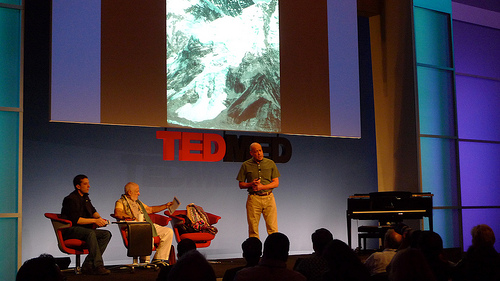The New Yorker (9 July 2012) has an article on TED Talks.
TED stands for Technology/Entertainment/Design and is a conference venue for some of the most magnificent speakers.
Just looking at some of TED’s “most popular this month”–turn to TED if you want to hear about:
– Information being collected about you on the web
– How through vulnerability, we can empathize, belong, and love
– Whether through evolution our kids will be different than us
– Ways to prepare for Alzheimer disease
– New ideas for cleaning up oil spills
– How schools kill creativity
– The talents and abilities of introverts
– How to inspire and be a great leader
TED is literally a world of information and it is presented in a high quality way.
Almost anyone would be floored by the honor to present at TED.
Talking at TED means not only that you have something important to say, but that you can pull-off saying it the right way.
What makes TED lectures great though (and viewed 800 million times so far) maybe also makes them more than a little sterile.
Firstly, the 4-day TED conference itself is only for special people–admission starts at $7,500 and no that does not include lodging and travel, and you have to have an “invitation”–posh posh–to attend.
Then, the actual presentations are “closely governed”–speakers are carefully sought out and vetted, material that is counterintuitive is of interest, and “TED’s eye for theatre…[with] vigilance about immersion and control” are a strong part of the showmanship.
However, while on one hand, these things perhaps are a hugh part of the TED success–wash, rinse, repeat–on the other hand, it also makes for a feel that is very scripted, uniform, almost molded.
The New Yorker article even describes how the speakers practice again and again–repeating their monologues hundreds of times and to whoever will listen. There is essentially nothing impromptu, ad-libbed, or in a sense real about the entertainment-aspect of what you are watching and listening to.
While the information seems to always be great–the presentation with the speaker, sound, lights, slide show, audience shots, etc.–comes across like a row of identically-built houses in a development.
Each “house” (or presentation in this case) may be filled with interesting people, things, and love, but on the outside, as one of my friends says–they are identical, so that coming home after a long day at work, you almost don’t know at times which row house is yours anymore.
If TED ever did a lecture on how they could improve TED. these would be some of my suggestions (and there is no gloss here):
– Open it to everyone–Restricting TED to invitation-only is elitist and maybe worse. Opening TED to more people to attend, learn, and enjoy–let’s everyone have an opportunity to benefit–regardless of who you are or where you come from.
– Diversify the speakers–It is nice to have scientists and entrepreneurs and stars present at TED, but it would be even nicer to have regular, common people too. Everyone has a story to tell–whether or not you have a Ph.D. or run your own company. While it is great to learn from the “experts,” it would be fascinating to hear from everyday people on their challenges and how they deal with them and overcome them or not. Just as an example, regularly, I see an incredible homeless lady on the street in DC–yes, well-dressed, talkative, polite–and I would want to hear how she ended up where she is and how she copes and survives her experiences on the street everyday. The point it that every person is a world onto themselves and worth hearing about–the key is how to get the experiences, the feelings, and the lessons learned.
– Genuine, less scripted speeches–Part of good entertainment is making it real, but when it is just another (over-)rehearsed performance, the speakers seem almost robotic. Wouldn’t it be wonderful to hear human beings talk in a more relaxed and yes, genuine-way about very important human topics of significance to us all? Right now, people crave information –heck, it’s the information age and nice informative lectures are racking up the views, but at some point soon, people are going to want and expect more.
– Shake it up with the venue–TED is conservative extraordinaire. The one (or occasionally two or three) speakers on the stage, the dark background and spotlighted speaker, the PowerPoint or Prezi presentation, the dangling microphone, the opening applause, the slow and methodical speech–yes TED is “ideas that inspire,” but it is also a venue that bores. Perhaps, if you are an avid conference attendee and like the routine, copy-cat set-ups, you feel at home in TED. But why not let people talk here, there, and everywhere–let someone speak on the street, in a park, on a ship, or even parachuting off a plane. How about someone on the International Space Station? Or on the front lines in a major military engagement. People have a lot to say and where they say it–says a lot about them and adds to their message. A stage is a stage. Even a snake-oil salesman has a soapbox.
Not to be confused with TED, there are TEDx events–“TED-like” that are organized by volunteers on a community-level, a “do-it-yourself TED” that is occurring at a “global rate of about five per day”–and these come closer to the open ideal, but still more can be done to make TED itself an organization where truly ideas come from all people, for all people.
While TED’s brand is exclusive and valuable–perhaps more important is education that is valuable for the masses.
(Source Photo: here with attribution to Juhan Sonin)


